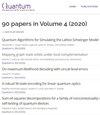有限维系统中的$su(d)$-挤压和多体纠缠几何
IF 5.1
2区 物理与天体物理
Q1 PHYSICS, MULTIDISCIPLINARY
引用次数: 0
摘要
推广了著名的自旋压缩不等式,研究了在多粒子系统中,集体$N$-粒子$su(d)$算子的压缩与多体纠缠几何的关系。为了达到这个目的,我们定义了伪可分态集,它是位于$(d^2-1)$维Bloch球中的单粒子态的乘积的混合物,但不一定是正半定的。我们得到了$N$ qudits的状态符合上述形式的一组必要条件。任何违反这些条件的状态都是纠缠态。我们还定义了一个相应的$su(d)$-压缩参数,可用于检测大粒子系综中的纠缠。在几何上,这组条件定义了集合$N$-粒子$su(d)$算子的一阶矩和二阶矩空间中的凸点集。证明了在极限$N\gg 1$中,这样的集合是由伪可分状态填充的,而在这个集合之外的点对应的任何状态都必然是纠缠态。我们还研究了由这些不等式检测到的状态:我们表明,当且仅当两体约化态违反正偏转置(PPT)准则时,具有玻色子对称的状态才被检测到。另一方面,检测到接近$su(d)$单重态的高度混合态,它们具有可分离的两体还原态,并且对于所有可能的双分态也是PPT。我们还提供了由我们的不等式集检测到的热平衡状态的数值例子,将自旋压缩不等式与$su(3)$-压缩不等式进行了比较。本文章由计算机程序翻译,如有差异,请以英文原文为准。
$su(d)$-squeezing and many-body entanglement geometry in finite-dimensional systems
Generalizing the well-known spin-squeezing inequalities, we study the relation between squeezing of collective $N$-particle $su(d)$ operators and many-body entanglement geometry in multi-particle systems. For that aim, we define the set of pseudo-separable states, which are mixtures of products of single-particle states that lie in the $(d^2-1)$-dimensional Bloch sphere but are not necessarily positive semidefinite. We obtain a set of necessary conditions for states of $N$ qudits to be of the above form. Any state that violates these conditions is entangled. We also define a corresponding $su(d)$-squeezing parameter that can be used to detect entanglement in large particle ensembles. Geometrically, this set of conditions defines a convex set of points in the space of first and second moments of the collective $N$-particle $su(d)$ operators. We prove that, in the limit $N\gg 1$, such set is filled by pseudo-separable states, while any state corresponding to a point outside of this set is necessarily entangled. We also study states that are detected by these inequalities: We show that states with a bosonic symmetry are detected if and only if the two-body reduced state violates the positive partial transpose (PPT) criterion. On the other hand, highly mixed states states close to the $su(d)$ singlet are detected which have a separable two-body reduced state and are also PPT with respect to all possible bipartitions. We also provide numerical examples of thermal equilibrium states that are detected by our set of inequalities, comparing the spin-squeezing inequalities with the $su(3)$-squeezing inequalities.
求助全文
通过发布文献求助,成功后即可免费获取论文全文。
去求助
来源期刊

Quantum
Physics and Astronomy-Physics and Astronomy (miscellaneous)
CiteScore
9.20
自引率
10.90%
发文量
241
审稿时长
16 weeks
期刊介绍:
Quantum is an open-access peer-reviewed journal for quantum science and related fields. Quantum is non-profit and community-run: an effort by researchers and for researchers to make science more open and publishing more transparent and efficient.
 求助内容:
求助内容: 应助结果提醒方式:
应助结果提醒方式:


